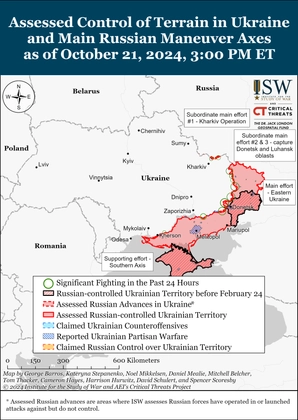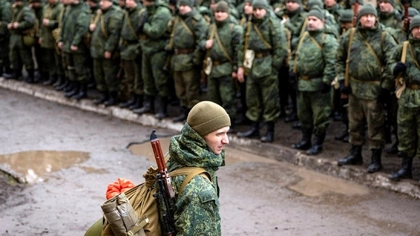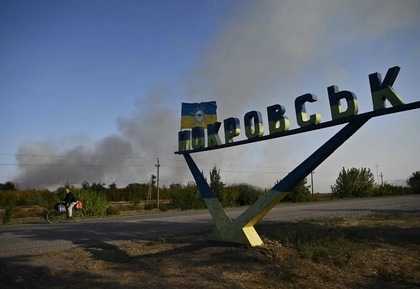While mobilization continues inside Russia, historic buildings in Ukraine’s occupied territories are being turned into fortresses.
In the southern Siberian Republic of Tuva, homeland of Russian Defense Minister Sergei Shoigu, the local authorities are trading men for sheep. For each mobilized man, his family receives a live sheep, flour, potatoes, cabbages, and, of course, coal for heating the house in winter. Coal is needed because Russia has not laid gas pipes to the homes of people in Tuva nor many other regions and autonomous republics.
JOIN US ON TELEGRAM
Follow our coverage of the war on the @Kyivpost_official.
Mobilization is slow. Those who are called up complain that they lack military uniforms, that the food is meager, or that they are forced to spend the night in fields, despite winter already beginning in some regions.
Some men mobilized into the Russian army have already found themselves at the front and even in captivity. The promise of military training did not materialize. Judging by the interviews that Ukrainian journalists have undertaken with newly captured recruits, they are very pleased that the war ended quickly for them. Most of those mobilized did not want to fight, but had insufficient money to escape to Georgia, Mongolia, or Kazakhstan.
The Russian army on the defense
The evacuation of Russian civilian specialists from occupied Lysychansk (738 kilometers southeast of Kyiv) has already been announced. Russian electricians and builders who came to the occupied city of Severodonetsk (close to Lysychank) to rebuild infrastructure, are already leaving for Russia. They do not want to be caught in Ukrainian artillery fire.

ISW Russian Offensive Campaign Assessment, October, 22, 2024
While the Ukrainian Armed Forces (UAF) is advancing in several sectors of the front, the Russian army is actively preparing for defense. The combat effectiveness of the Russian army cannot be underestimated, and Russia still has much more artillery and many more tanks and aircraft than the UAF.
In Luhansk region, the Russian forces received an order to “stand to the death.” They are forbidden to retreat and so are looking for reliable buildings – those that can be turned into hard-to-reach fortresses.
One such place turned out to be the complex of the regional psychiatric hospital in the town of Svatove (735 kilometers southeast of Kyiv): a dozen old one-and two-story buildings with thick brick walls and deep underground rooms.
Before the outbreak of hostilities, more than 500 patients lived here and were cared for by 340 staff. Recently, the Russian military evicted hospital patients and the remaining staff and began to fill the territory with ammunition and weapons. It is not clear what awaits the patients evicted from the psychiatric hospital. I doubt that the Russians will take patients to Russian hospitals, but it is clear what awaits the hospital complex itself. It was overhauled using budget money only a year ago, but if it becomes a military stronghold, it will be destroyed.
Hospitals once more under attack
In Ukraine, ancient, massive and well-fortified castles, fortresses, and estates were often used as psychiatric hospitals and specialized boarding schools. This practice dates back to Soviet times, when the Soviet government wanted to isolate mentally ill citizens from the world of healthy people. In Russia, where there were fewer such castles or estates, psychiatric hospitals were usually located on river or lake islands.
Now, most of the psychiatric hospitals in the occupied territories have been closed and taken over by the Russian military.
In the Kharkiv region during the second half of September, the village of Strelcha found itself the target of Russian shelling. Doctors and orderlies tried to evacuate patients from the psychiatric hospital. Of the 600 patients, only 30 could be taken to a safe place, while four doctors were killed and two patients left injured.
Historic buildings in the center of battle
As was the case in the Middle Ages, the Russian military favors using ancient churches and monasteries as fortifications – not so much a sign of their faith, but for their thick and ancient stone walls.
St. Grigorievsky Bizyukov Monastery, in the village of Krasny Mayak, Kherson region, has become one such fortress of the Russian army. It is not clear where the monks are now, but if they remained in the monastery, they would no doubt be able to add new tragic pages to the site’s documented history.
The monastery was founded in the late 18th century. In 1919, during the civil war that followed the revolution of 1917, it was captured by soldiers of the Red Army. They made the monastery their fortress from which they were able to launch raids on nearby villages. The Red Army held the monks hostage, mocking and beating them. Some were killed. The monks found a way to secretly send word about their treatment to the commander of the free Cossacks, Ataman Osaulenko, who was camped with 100 Cossack fighters in the nearby town of Berislav.
With his small army, Osaulenko unexpectedly attacked the Red Army soldiers in and around the monastery, who numbered up to 2,000. The Cossacks won and drove the soldiers out of the monastery. But many buildings of the monastery were destroyed and, later, the Red Army returned and murdered all the monks.
During the Second World War, the Germans removed the monastery’s valuables – including the church silver, hidden by the monks during the 1917 revolution. In the 1970s, by order of the Soviet authorities, the main cathedral of the monastery was blown up. Restoration work began in the 1990s. By 2021, work to rebuild the almost three-meter-high stone walls around the monastery was complete.
The lengthy restoration work was paid for with money collected by believers throughout Kherson region. If the Russian military starts shooting from the territory of the monastery once again, the UAF will shoot back. The thick walls might survive bullets but are unlikely to survive missile attacks.
The Russian military takes an interest not only in ancient fortifications and church buildings, but also antiques, especially military antiques. In the liberated city of Izyum, Ukrainian soldiers found a box with ancient weapons stolen by the Russian military from the local historical museum. The Russian army left Izyum in a hurry and, apparently, forgot about their loot. Now, the ancient weapons will return to the museum.
Some ancient religious texts will also be returned to the museum, including the gospels, published at the expense of Hetman Mazepa in the early 18th century. They were hidden at home by the museum’s curator, Dina Listopad. With tears in her eyes and a smile on her lips, she now gives interviews to reporters, recounting how she managed to save these valuable texts.
Views expressed are the author’s and not necessarily of Kyiv Post.
You can also highlight the text and press Ctrl + Enter






